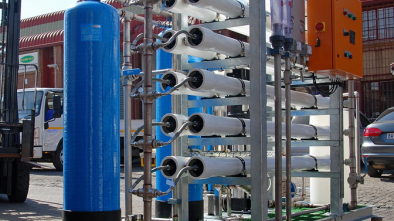Reverse Osmosis (RO) is a separation technique that is suitable for a wide range of applications, especially when salt and/or dissolved solids need to be removed from a solution. It is one of the most common types of water treatment.
According to Anelia Hough, water treatment consultant at Allmech, leading South African manufacturer of boilers and supplier of water treatment components, there are several factors to be considered when selecting an RO system: the customer’s capacity requirement (i.e. water usage), the daily production capacity of the system, and the percent rejection for specific contaminants in the source water.
“Beyond this, RO plants require proper maintenance and care to ensure they function optimally and to extend their lifespan,” she says. “Aside from regular maintenance, the best way to protect a RO plant is by pre-treating water, which reduces the strain on the RO membrane – a costly component. It also helps to avoid issues like scaling and bio-fouling.”

Common Issues with RO Plants
“Factors that can affect a RO system’s performance include temperature, operating pressure, back pressure, the equilibrium effect/TDS creep, percent recovery, and, of course, the RO membrane’s permeate production and percent rejection ratings,” says Hough.
The most common issues in RO plants include:
• Fouling: occurs when contaminants accumulate on the membrane surface, effectively plugging the membrane. There are many contaminants in municipal feed water that are harmless for human consumption, but large enough to quickly foul (or plug) an RO system.
• Scaling: when particles are deposited on a membrane, causing it to plug. As certain dissolved compounds become more concentrated, scaling can occur if these compounds exceed their solubility limits and precipitate on the membrane surface as scale. Scaling calculations are usually only based on the silicate concentration in the feed water.
• Biofouling: reduces actual membrane performance through microbial generation in a biofilm that forms on the membrane surface.
• Chemical damage: on a RO membrane, this means a higher permeate flow and poorer quality permeate water. Dosing of oxidant agents, such as chlorine or hypochlorite, can reduce performance and ultimately result in the failure of the RO membranes. Use of aggressive cleaners can also cause chemical damage.
• Mechanical damage: can happen when a system is pressurised too quickly, damaging the RO membrane elements. One of the most clears signs of damages on a RO membrane is the lack of salt rejection capabilities. There is also very often an increase of permeate flow rate.
Pre-treatment can help to avoid these problems, and Hough says there are various options available.
Pre-treatment Options
“When selecting a pre-filter, users should always look for a verified efficiency rating next to the micron size on the filter’s technical data sheet,” says Hough.
• Multi Media Filtration: A multi-media filter is used to help prevent fouling of a RO system. This type of sediment filtration is ideal for a pre-treatment process to any reverse osmosis system helping to ensure long life of the RO membrane elements. A well operated multimedia filter can remove particulates down to 20 microns. A multimedia filter that uses a coagulant addition can remove particulates down to 10 microns.
• Micro Filtration: The filters used in microfiltration have a pore size of approximately 0.1 micron. Bacteria and suspended solids are the only element that can be removed through microfiltration.
• Antiscalants and scale inhibitors: There are many chemicals that can be used as antiscalants and dispersants to improve the operation of RO. Antiscalants are a family of chemicals designed to inhibit the formation and precipitation of crystallized mineral salts that form scale.
• Softening by ion exchange: A water softener is a filtration system that removes hardness-causing calcium and magnesium minerals from water through a process called ion exchange. Standard water softeners are cation exchange devices. Cation exchange involves the replacement of the hardness ions with non-hardness ions.
• Granular Activated Carbon (GAC) Filtration: Activated carbon removes residual chlorine and chloramines by a chemical reaction that involves a transfer of electrons from the surface of the GAC to the residual chlorine or chloramines. The chlorine or chloramines end up as a chloride ion that is no longer an oxidizer.
“It’s also important to clean the RO membrane regularly,” says Hough. “This involves low and high pH cleaners to remove contaminants from the membrane. We address scaling with low pH cleaners and organics, while colloidal and biofouling are treated with a high pH cleaner.”
Allmech offers the complete range of pre-treatment and RO membrane maintenance solutions for RO plants, including filtration systems, softeners, antiscalants, chemicals and other consumables.
“At Allmech, we’re looking forward to growing this part of our business in 2022 and beyond, leveraging our experience in all things related to water treatment. We also have a boiler division and we stock a comprehensive range of Runxin valves, so we’re well positioned to be a one-stop shop for anyone needing a water treatment or boiler specialist, and we’re expecting a busy year ahead,” Hough says.


